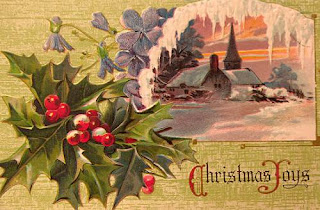The custom of sending Christmas cards started in the U.K. in 1843 by Sir Henry Cole. He was a civil servant (Government worker) who was very interested in the new 'Public Post Office' and wondered how it could be used more by ordinary people.
Sir Henry had the idea of Christmas Cards and with his friend John Horsley, who was an artist, they designed the first card and sold them for 1 shilling each. (That is only 5p today(!), but in those days it was worth much much more.) The card had three panels. The outer two showed people caring for the poor and the centre panel was a family having a large Christmas dinner! Some people didn't like the
card because it showed a child being given a glass of wine!
The first post that ordinary people could use was started in 1840 when the first 'Penny Post' public postal deliveries began. Before that, only very rich people could afford to send anything in the post. The new Post Office was able to offer a Penny stamp because new railways were being built. These could carry much more post than the horse and carriage that had been used before. Also, trains could go a lot faster. Cards became even more popular in the UK when they could be posted in an unsealed envelope for one halfpenny - half the price of an ordinary letter.
As printing methods improved, Christmas cards became much more popular and were produced in large numbers from about 1860. In 1870 the cost of sending a post card, and also Christmas cards, dropped to half a penny. This meant even more people were able to send cards.
An engraved card by the artist William Egley, who illustrated some of Charles Dickens's books, is on display in the British Museum. By the early 1900s, the custom had spread over Europe and had become especially popular in Germany.
The first cards usually had pictures of the Nativity scene on them. In late Victorian times, robins (an English bird) and snow-scenes became popular because the postmen in that time were nicknamed 'Robin Postmen' because of the red uniforms they wore. Snow-scenes were popular because they reminded people of the very bad winter that happened in 1836.
Christmas Cards appeared in the United States of America in the late 1840s, but were very expensive and most people couldn't afford them. It 1875, Louis Prang, a printer who was originally from German but who had also worked on early cards in the UK, started mass producing cards so more people could afford to buy them. Mr Prang's first cards featured flowers, plants, and children. In 1915, John C. Hall and two of his brothers created Hallmark Cards, who are still one of the biggest card makers today!
In the 1910s and 1920s, home made cards became popular. They were often unusual shapes and had things such as foil and ribbon on them. These were usually too delicate to send through the post and were given by hand.
This information found at : http://www.whychristmas.com/customs/cards.shtml







No comments:
Post a Comment